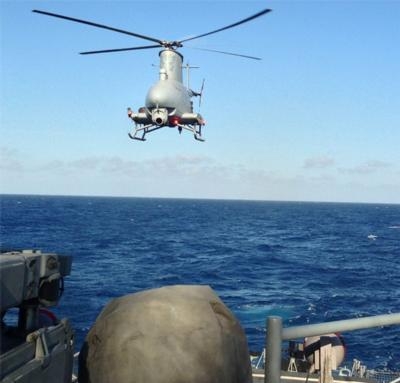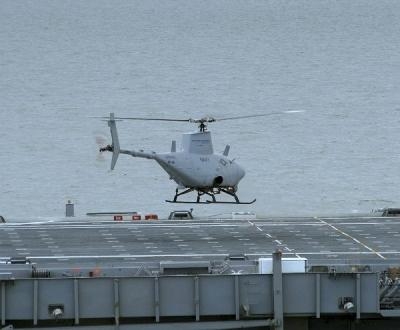Mon, Apr 08, 2013
Logged 600th Deployed Flight Hour On The Last Day Of March
The U.S. Navy’s MQ-8B Fire Scout unmanned helicopter surpassed another milestone in March when the MQ-8B Fire Scout helicopter completed its 600th deployed flight hour while embarked on USS Robert G. Bradley (FFG 49). The unmanned helicopter, part of Helicopter Sea Combat Squadron (HSC) 22, logged its 600th deployed flight hour March 31. This record exceeds the previous Fire Scout deployment milestone by 100 hours and will likely climb higher with nearly two months remaining on the frigate’s Mediterranean deployment.

This is the fifth sea-based deployment for the MQ-8B. Fire Scout routinely flies 17 hours per day, while providing a 12-hour real-time Intelligence, Surveillance and Reconnaissance (ISR) orbit to combatant commanders. USS Bradley received communication upgrades allowing the aircraft’s Full Motion Video (FMV) camera feed to be distributed to the ship’s Combat Information Center (CIC) and to commanders at military installations throughout the world.
“The teams of USS Bradley and HSC-22 have taken Fire Scout and maritime ISR to a new level,” said Capt. Patrick Smith, Fire Scout program manager at Naval Air Station Patuxent River, MD. “They tackled multiple sparing, integration and operational issues. Their perseverance demonstrated the significance of maritime based ISR. Fire Scout continues to be in great demand and is answering the call globally via our shipboard deployments.”
Smith said the team will continue to take lessons learned and provide improvements to future deployments. "The U.S Navy brings a unique capability to the ISR customer,” said Cmdr. Pete Ehlers, USS Bradley commanding officer. “Fire Scout is a proven technology with greater multi-payload and mission capability than smaller UAVs the Navy operates. We are able to access many areas of interest without adding an undesirable U.S footprint on land.”

Since 2006, the Northrop Grumman-built Fire Scout system has flown more than 8,000 flight hours – with more than half of the flight hours performing real-world operational tasking during ship-based and land-based deployments within the past 18 months. This deployment also marks the first time that an HSC squadron has deployed with the Fire Scout. Previous deployments have all been conducted by the Helicopter Maritime Strike community.
“I’m extremely proud of our aircraft maintainers and aircrew”, said Lt. Cmdr. Brett Meskimen, HSC-22 officer in charge. “Our active and Reserve Sailors took the lessons from the previous deployments and ran with them. They have set the new standard for future detachments from both communities. We still have a long way to the end of deployment, but it is worth taking a moment to reflect on the hard work and accomplishments of the whole team as they support the needs of the warfare commanders.”
(Image courtesy of the U.S. Navy)
More News
States That Current Process is Damaging National Aerospace Development US Senator Jerry Morgan is pushing the FAA to speed up the process for rocket launch licensing. He argues tha>[...]
From 2015 (YouTube Edition): Model Aviator Aims For Full-Scale Career While at the 2015 Indoor Electric RC Festival, referred to as eFest, ANN CEO and Editor-In-Chief, Jim Campbell>[...]
Dave Juwel's Aviation Marketing Stories ITBOA BNITBOB ... what does that mean? It's not gibberish, it's a lengthy acronym for "In The Business Of Aviation ... But Not In The Busine>[...]
Aero Linx: Cardinal Flyers Online The Cardinal Flyers Online Web site was created and is maintained by me, Keith Peterson. My wife Debbie and I have owned a 1976 RG since 1985. Wit>[...]
Clearance Void If Not Off By (Time) Used by ATC to advise an aircraft that the departure release is automatically canceled if takeoff is not made prior to a specified time. The exp>[...]
 Senator Pushes FAA to Accelerate Rocket Launch Licensing
Senator Pushes FAA to Accelerate Rocket Launch Licensing Classic Aero-TV: RJ Gritter - Part of Aviations Bright New Future
Classic Aero-TV: RJ Gritter - Part of Aviations Bright New Future Aero-FAQ: Dave Juwel's Aviation Marketing Stories -- ITBOA BNITBOB
Aero-FAQ: Dave Juwel's Aviation Marketing Stories -- ITBOA BNITBOB ANN's Daily Aero-Linx (10.27.24)
ANN's Daily Aero-Linx (10.27.24) ANN's Daily Aero-Term (10.27.24): Clearance Void If Not Off By (Time)
ANN's Daily Aero-Term (10.27.24): Clearance Void If Not Off By (Time)




